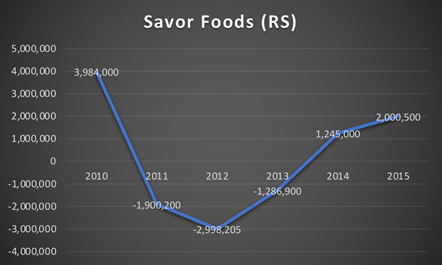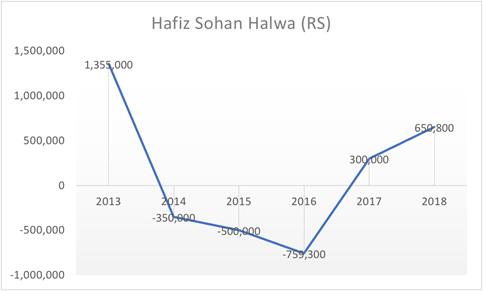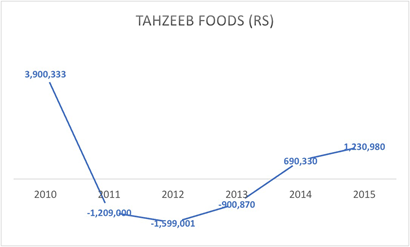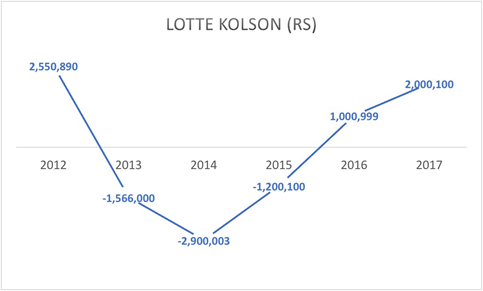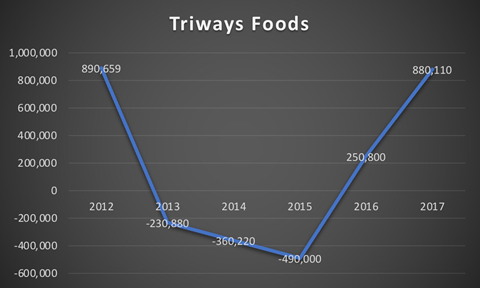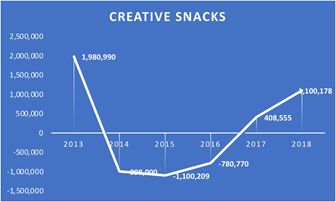Turnaround strategy:
These are the strategies companies adopt consciously to enhance their business’s growth and operations. Sometimes these are carried out to recover from being in a constant declining sales of the company. It is basically a range of measures that the higher authorities put forward in order to flourish the sales and growth of their businesses. These strategies help in re-framing and enhancing the overall operations of the business. Most of the companies that tend to adopt these strategies usually encounter recession or stagnation in their business’s economic culture (Hofer, 1980).
Turnaround strategies implemented by Pakistan’s food manufacturing industry:
Pakistan’s food manufacturing industry’s history is full of booming and decline of few of its companies sales. The most important factor can be Pakistan’s highest number of receiving imports of international food companies and their supplies, the emerging trend of shifting to international products made the country lose insight of what is actually being produced and operated in its own country. Moreover, the economic conditions of Pakistan (production, growth, lack of resources (food items), lack of natural resources (power, water, gasoline, etc), lack of human resource, improper leadership, supply, import/export) has also been identified as the key factors that companies face stagnation in the overall structure of their company. In this case, the following are the mentioned below few strategies that Pakistan food manufacturing companies adapt to revive their sales and growth of the business after 2010:
- Managerial restructuring:
Restructuring is the term used basically for aligning the management of a business to reorganize or restructure its operations, define the roles and duties, changing of priorities, upgrading of trends, and bringing improvements in the overall services of the company. While managerial restructuring typically refers to the corporate managerial acts of re-aligning all the operations and trends of the business according to the need of the hours, to survive and compete in the market (Robbie & Wright, 1995). It may involve training managers and human resources of the company or organization or change the leadership style that eventually helps the business to generate maximum revenue.
- Operational restructuring:
The term “operational restructuring” generally arrives from determining the problematic areas of the operations of a business or an organization. It helps in identifying that what basically is the area that went underperformed or lacked proper determination to excel (Harrigan, 1988). This strategy then proposes suitable alternatives and ways to cope up with the situation and improve the overall operations of a business.
- Asset restructuring:
Asset restructuring refers to keeping the assets and liabilities off the balance sheet balanced, the right use of the ownership, maximizing revenues, minimizing costs, and improving the overall cost efficiency of the firm/business (Douponcel, 1998). Businesses use asset restructuring to maintain a proper balance in the operational costs and revenues of the firm and hence improves the overall stability of a business.
- Financial restructuring:
As the name of the strategy depicts, it refers to the financial balancing of the business’s structure. It involves improving the equity and debt capital of the business. While financial restructuring, a business can determine whether the finances of the business are running in order or is there any further need of aligning and restructuring of business capital. It helps to improve the overall financial status of a business (Kalogeras, Baourakis, Zopounidis, & Van, 2005).
- Cost efficiency:
Cost efficiency strategy aims at minimizing the company’s costs and maximizing revenues. This phenomenon helps businesses to generate more revenues and make savings efficient. Moreover, it focuses on whether all the costs that are being spent on the business are fair or is there any other factor on which costs are being utilized that arent necessary. For example, balancing the human resource or labor of the company and keeping a check that no exceeding costs are being spent on the wages of those who aren’t even needed (Handy & Padberg, 1971).
- Focusing on the company’s core activities:
Many businesses today, while coping up with the market-evolving trends often forget about their specialty. By remain in competition they lose sight that what is their best selling product that earned them a handful of sales, this strategy reminds them of the value that they promised to deliver. Businesses should cope up with the market ever-evolving trends but must never lose sight of their value proposition that helps them stand out.
- Transferring leadership:
Transferring leadership and bringing out reforms can help a business save a lot from facing a downfall. Sometimes an ideal leadership idea and style is what a business demands in order to survive in the market and retain their quality human resource. If a business is in the state of being stagnant, it is a quite smart move to change the leadership style and tactics.
Companies opted for turnaround strategies after 2010:
- Gourmet foods:
Gourmet foods has been serving Pakistan for more than three decades now, and is well known for its baking and confectionery items. It is first founded by Mr. Muhammad Nawaz Chattha and the legacy and leadership are now being transferred to their sons. The functional unit of gourmet is located in Lahore along with 100 other retail stores (Curtis, Cowee, Havercamp, Morris & Gatzke, 2008). Furthermore, they have been extended over to seven other stores within Pakistan. But since to arising competition (Jalalsons etc) and the home-based small business started taking over the largest confectionery unit of the country, the company, however, experienced a dropping number of sales and hence the wastage of their produced items growing immensely. So the owners brought about the following mentioned below strategies in order to bring their business back into the competition:
- Managerial restructuring:
The managerial restructuring took place when the growing need of moving to digital platforms took place. Hence, it was a smart move for gourmet to rebuild their managerial setups and trends and hire the social media and digital specialists, and analysts that helped gourmet gain their market share in less time. They felt a strong need of hiring a person that has an insight into the digital world to sustain in the market for a relatively long period and make gourmet their family’s legacy.
- Operational restructuring:
When gourmet successfully adopted the latest and emerging managerial trends of a business, their need of restructuring their operational needs grew alongside. So they started getting a closer vision of their company’s operational infrastructure. It was a part of gourmet’s operational restructuring that led them to determine the need for going digital and in the time of the pandemic, their strategy helped them get the maximum number of sales (Curtis, Cowee, Havercamp, Morris & Gatzke, 2008).
- Asset restructuring:
The phenomena of restructuring the assets of gourmet, the managerial body made specific decisions (going digital and serving online) that made them generate maximum revenues and aims to minimize their other costs. This strategy helped gourmet aligning its revenues and expenses in a way that helps the company earn the most out of it.
- Financial restructuring:
The financial restructuring strategy of gourmet made them realize the importance of their equity-based and set capital. So by realizing the need of aligning both of their capitals they structured their costs and assets in the best possible direction that led them to save more and limit their expenditures. Financial restructuring especially in the era of pandemic made gourmet limit their giant expenditures and identified a strong need to strategize their business in a way that saves them more. The small insight of the financial status of the company after 2010 has been drawn in the graph below:
- Savor foods:
Savor foods have been serving Pakistan, especially the capital city for more than three decades now. And has grown rapidly to all different regions of Rawalpindi and the capital with time. Savor foods have been widely known for being the cost leader in the market. It has made it their value proposition and strength, besides an immense number of competition being entered to a food industry of Islamabad and Rawalpindi. Savor didn’t let its position down, it has mainly targetted the middle class of the society. However, due to its taste and consistently high standards of quality, it’s had tapped the interests of the elite class as well. But savor has now expanded to different areas of the country, I.e. Lahore and Wah Cantt. It has made its taste and services available to all areas so as to tap a larger market and generate sales by proving them their promised services.
- Cost leadership strategy:
Savor undergoes a cost leadership strategy throughout the three decades of serving customers. It has promised to deliver the best quality of food at the most affordable prices throughout and remains consistent with their words, their strategy throughout made them won the confidence of tons of their regular customers.
- Asset restructuring:
Savor underwent the asset restructuring approach, and has desired the most promised means of serving customers by capturing in return the maximum revenues and spent all of the costs in expanding their business and capturing larger markets. However, the financial status of Savor foods for the years 2010-1015 has been drawn below:
- Hafiz Sohan Halwa:
It was first founded back in 1930, and it’s been near a century since when Hafiz family continued to serve Multan with its most desired and royal taste of Halwa. Moreover, it has also won two of the American quality awards, because of its great taste and consistently high standards of quality throughout the century. It’s a legacy for their family as the owners provided the highest quality of education to their next generation as well so they can pursue their business. As their sons have been entering into the business, they felt different and creative needs of expanding the business and make them available to the whole country. Going digital was another smart move of the family, the latest trends of the market, higher education, and a specialization in hotel management from Thailand served their business with tons of revenues. The only factor that seemed endangered in the history of the Hafiz family’s business was a growing competition and a backlash of increasing expenditures, so they felt a need of implementing various strategies to their business:
- Managerial restructuring:
Managerial restructuring became a thing when there wasn’t a single manager of a business. All family members worked collectively, provided solutions and creative alternatives to help the businesses run a smooth operation and make more sales. Their managerial body varies according to the situation, whoever proposes a solution or comes up with a strategy has to take over the business till they reach their goals.
- Operational restructuring:
Since the business of the Hafiz family ran over for about 8 decades many sorts of issues and problems interposed in their way, so the main need of remaining in the competition was to remain up to date with the markets emerging trends and needs. Going digital and expanding to various regions of a country was one of the operational structuring needs of their business that their sons gladly and efficiently took over.
However, the financial status of their business for the year 2013-2018 is depicted in the graph below:
- Tehzeeb foods:
Tehzeeb foods have also been known for serving the twin cities of Pakistan, with a legacy of over 100 years. The high standards of quality, taste, and cost-effectivity made Tehzeeb win over the confidence of a large number of an elite class of the twin cities, including the President, Ambassadors, Prime ministers, and even the Royal families that visit Pakistan. Tehzeeb has also been awarded to provide the best ever quality standards of orders for the royal and other high-class ceremonies. It delivers high and promising standards of the cultural heritage of a country. Despite of the emerging competition especially in the twin cities of Islamabad and Rawalpindi, Tehzeeb remains consistent and doesn’t let itself fall down.
- Managerial restructuring:
Tehzeeb bakers undergo managerial restructuring by time to time whenever they felt a need of bringing creative and innovative solutions to the business. They have the high standards of remaining up to date with the market’s leading and emerging trends in order to remain in the competition and cope up with the internalized needs of a business to stay in competition.
- Operational restructuring:
Tehzeeb bakers cope up with the operational restructuring strategy of the business by determining the time to time need of bringing about reforms in the business and adopt innovative solutions to the trends. Bringing reforms, I.e. Going digital and offer customized solutions to the customers’ needs, according to their preferences and desires are all a part of the operational restructuring of Tehzeeb bakers.
Following are the financial graph of Tehzeeb for the year 2010-2015:
- Lotte kolson:
“Lotte Kolson” named after the K.S.Sulaimanji and Esmailji & sons, with the merger of Lotte corporation, South Korean based industry. Collectively gave rise to a Lotte Kolson, headquartered in Karachi. It has been serving the world since 1942. It is known for its quality based confectionary and snack items. It is the first Pakistani-based industry with a large share of international exports. It has faced a backlash before 2010, due to a lack of coping up with the market’s emerging trends. Kolson lacked in carrying out the promotional strategies that were needed back them to sustain in the market.
- Leadership strategies:
Kolson corporations after a backlash, however, felt a strong need of change in the leadership style and a strong need of carrying out the promotional strategies. The emergent leaders felt a strong need of hiring the digital and social analysts and experts that leads kolson’s to gain it’s market share back.
- Operational restructuring:
- Kolson being called for a new and experienced marketing person who had a keen knowledge of dealing with the world outside firm and that can help Kolson stand strong in the digital and social media world.
- Strong need for promotional strategy
These are the two approaches of operational restructuring that let Kolson determine the area where it is lacking its capabilities to earn back its market growth and market share.
- Financial restructuring:
Kolson undergoes financial restructuring by identifying and limiting the extra expenses that the company might have any and aligned them with the useful resources that are required primarily by the business. This phenomena helped kolson maximizing it’s revenues and spend most part of it on the promotional strategies of a company. However, the financial graph of Kolson for the year 2012-2017 is as follows:
- Triways foods:
Triways food industries has been providing it’s services to Pakistan for more than four decades. Triways foods are known for producing around 60 none-paper products to the regions where they initiated their business for the first time ever. It specializes in the production of confectionary and bakery items. By 2013, it expands its business in providing mineral water services and later by 2016 stated operating in snacks industry as well. Due to immense competition, just like Kolson, Fridays lacked their promotional strategies and couldn’t stand strong in the market for a relatively longer period of time. Triways thought for itself that they have grown immensely that they won’t fall a victim of markets growing trends and competencies. But unfortunately, market’s ever-evolving trends proves them wrong and they had to face severe backlash that they had no option left but to transform themselves according to the needs of market and society.
- Managerial restructuring:
Triways undergoes managerial restructuring when find an immense need of changing leadership and companies strategies to cope well long with the marketing strategies of the company.
- Operational restructuring:
- Triways being called for a new and experienced marketing person who had a keen knowledge of dealing with the world outside firm and that can help Triways stand strong in the digital and social media world.
- Strong need for promotional strategy
These are the two approaches of operational restructuring that let triways determine the area where it is lacking its capabilities to earn back its market growth and market share.
Following is the graph representing the financial analysis of a company for the year 2012-2017:
- Creative snacks:
Creative snacks was founded back in 2008, which was widely distributed in eleven countries worldwide. It’s specializes mainly in snacks industry. Creative snacks are well known for their quality food, great taste, readily availability and convenience based products. The traditional style of making a product readily available to the targetted consumers and making sales out of it , made creative snacks loses a larger share of market as it didn’t cope up with the latest standards of businesses. In today’s world, businesses grow due to their constant innovation of trends and tactics, and lacking creative snacks capabilities in this aspect was a sign of alarming situation for the business.
- Managerial restructuring:
Creative snacks after determining it’s lacking behind in the business world tend to be focusing on the latest trends. By identifying a need of new managerial body and tactics that has an in-depth knowledge of the today’s businesses, creative snacks started hiring the new talent that will help their business grow their sales and their market share.
- Operational restructuring:
Determining the need of implementing and applying the latest and emergent business techniques into a business was one of the operational structuring scheme of creative snacks. Creative snacks thought that this is the main pain point of their business that they must need to resolve quickly before they went bankrupt.
- Asset restructuring:
Creative snacks falls for introducing the restructuring strategy of assets into their business. This strategy helped creative snacks to convert their business’s cash into useful strategies that ultimately helps them generate maximum revenue and minimize their other costs at the same time.
- Financial restructuring:
Creative snacks implemented financial restructuring strategy in order to align their business’s debts and equity capitals. These are the resources that creative snacks save so to spend on introducing on more useful strategies that help them gain the largest market share and grow internationally as well.
Drawn below is the financial graph of the creative snacks for the year 2013-2018:





